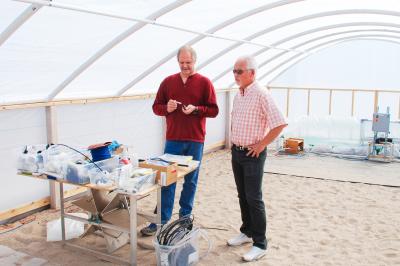POWER: NMSU explores algal biofuel production from wastewater

Just such a win-win approach is currently being designed and tested by researchers at New Mexico State University. If successful, their system will provide a more sustainable method for treating wastewater, a new viable approach to producing electric power and liquid biofuels, and a revenue stream to offset infrastructure improvements.
The approach is being called the POWER - photosynthetically oxygenated waste-to-energy recovery - system, according to Peter Lammers, research professor and technical director of NMSU's Algal Bioenergy Program.
Lammers and his colleagues have found that certain types of algae are highly effective in removing carbon, nitrogen and phosphorus compounds from municipal and agricultural wastewater.
"Unlike traditional wastewater plants that use bacteria for this purpose, processing wastewater using algal photosynthesis yields more biomass than the sludge output of current systems," Lammers said. "The economic key to the POWER system is converting algal biomass into liquid fuel and electric power."
The Desert Southwest offers an ideal environment, in many ways, for the production of algae. Abundant sunlight, mild temperatures, and wide open spaces for algae cultivation facilities have attracted new energy companies to the state, including Sapphire Energy, El Dorado Biofuels and Joule Energy.
But one essential component is in short supply in this arid environment: water.
It is this reality that has led researchers to explore using alternatives to fresh water that are less in demand, such as brackish water and municipal wastewater.
The conceptual breakthrough was to go beyond thinking about wastewater as an ingredient in algae production to thinking about algae as an ingredient in a newly designed sewage treatment system.
How will the new system work?
Algae will be cultivated in sewage water outdoors in large enclosed plastic bag containers - "closed photobioreactors" - that prevent evaporative water loss. They heat up much like a greenhouse but are much cheaper. Such PBRs also retain carbon dioxide, a nutrient for the algae,
thus fostering high-density algae production, and they keep wastewater odors and potentially harmful microbes contained.
The main inputs, in addition to sunlight, are the wastewater, the algae and the CO2.
The enclosed PBRs, given the appropriate strains of algae, will produce large amounts of algal biomass in a short period of time, while removing nutrients to yield clean discharge water.
The output of these PBRs is a broth that is then separated into biosolids that move into the fuel production components.
The success of the above system as a sustainable approach relies on efficiency at every stage. One challenge of the enclosed PBRs in desert environments is to prevent the intense summer heat from killing the algae.
The standard PBR solution to this problem is to regulate the temperature of the water using a cooling system, but of course that requires lots of electricity.
Lammers and his colleagues are exploring an alternative approach, specifically testing strains of algae that have evolved in high-temperature geothermal environments.
Such algae thrive in the hotter PBR temperatures. As an added benefit, these strains provide an acidified environment that, at the high daytime temperatures, promises to neutralize microbial pathogens in the wastewater. The algae are also mixotrophic, which means they can thrive during periods of low sunlight by removing organic carbon in the wastewater.
"Some of these hot springs algae can also tolerate extremely high CO2 levels, compared to most plants," said Wayne Van Voorhies, an NMSU microbiologist working on the project. "To cultivate these algae, we could use flue gasses directly out of a power plant, which are 10-15 percent CO2."
This suggests a role for such algae in CO2 recycling strategies.
Lammers and his colleagues hope that their enclosed PBR-based system could be adapted worldwide by employing a variety of different algae types with optimum temperature profiles compatible with different climates. It should also be scalable for communities of various sizes and, since it is a net energy producer, should be adaptable for communities in developing countries with inadequate or non-existent wastewater treatment facilities and severe resultant public health challenges.
According to Lammers, approximately two billion of the world's seven billion people live where there is no wastewater processing whatsoever.
Adrian Unc is an environmental microbiologist in NMSU's Department of Plant and Environmental Sciences whose expertise is in wastewater and human pathogens. He believes the system has great potential for improving human health.
"We think it would be rather easy and rapid to deploy such a system in any developing country that has the climatic conditions required, meaning sun and heat," he said.
Lammers also stressed that this basic approach could be adapted for waste treatment on large-scale dairy and livestock operations.
Several enclosed PBR prototypes are now being tested in a hoop house near existing algae testbeds at NMSU's Fabian Garcia Science Center. The hoop house was constructed to allow initial testing that would maximize system heat during the winter months.
The researchers are working with a species of hot springs algae from Yellowstone National Park and, with local winter climate conditions in mind, a species of Chlorella that Lammers says produces maximal levels of oil at somewhat lower temperatures.
Full outdoor testing will commence in the late spring. The performance of the various PBR designs and algae types will be evaluated to determine which combinations work best in the local environment.
"Modern sewage treatment processes were invented in an era of cheap energy," Lammers said. "'Business as usual' will not supply seven billion humans with clean air, clean water and energy."
In addition to Lammers, Unc and Van Voorhies, the multidisciplinary team of researchers on the POWER system includes Shuguang Deng in Chemical Engineering and Nirmala Khandan in Civil Engineering.
For more about NMSU algal biofuels research, go to http://research.nmsu.edu/erl/algalbiofuels/testbed/


